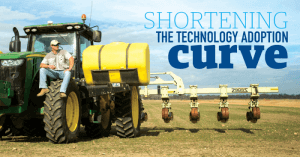Shorten the Precision Ag Technology Adoption Curve
Some farmers enter into precision agriculture with a single tool, function or outcome in mind. David Taylor started with more lofty ambitions, and it’s driven his technology adoption ever since.

Taylor’s initial goal 11 years ago was to create a network of tools and software that would collect data from every field operation on his farm near Como, Mississippi. He wanted to collect easy-to-navigate, actionable data that he could leverage in making decisions to improve the efficiency and overall output of his family’s 5,500-acre corn, soybean, cotton and peanut farm.
“The more I know, the more I realize I don’t know,” Taylor says. “Just when I think I’m going to figure something out, I lose it.”
Precision Ag and ROI
Taylor began integrating new precision ag tools into his operation shortly after his return to the farm in 2006. He’s made it a point to keep the learning curve short and always connect each new technology tool he integrates into his operation to his return on investment (ROI).
“I’m trying to be realistic about what is going to have ROI and what’s just going to end up being a toy,” Taylor says. “I want to be able to show that this stuff is paying for itself and that it’s making us money.”
In researching precision tools he felt were necessary to his farm’s future, he landed on Ag Leader as his provider, beginning with a yield monitor and guidance system and later adding more precise grid mapping to help him maximize crop input efficiency.
“We do a lot of grid soil testing, variable-rate applications and in-soil variable-rate nitrogen applications,” he says. “I realized I needed to focus not just on these specific functions, but do a better job of collecting and archiving all of this data. The more data I have and the more precise it is, the better off I will be.”
Technology Adoption Tips
Taylor recognizes that not all farmers are as quick to make precision agriculture a major part of their operation. That’s why he’s taken a cooperative approach in working with other farmers to first help educate them on technology and help them learn how to best begin to utilize it on their own farms. Here are a few points he considers in that process.
- Be open-minded. If what you’re using in the field is working, don’t seek a solution looking for a problem. It’s important to take an open-minded approach to technology that accounts for current machinery and expectations moving forward. “If what they have already is working well and meeting their needs, that’s great,” Taylor says. “An open-minded approach is important when adopting precision technology.”
- Leave emotion at the door. Many times, even with hard numbers in front of them that show the benefit of precision ag tools, it can be difficult to make major changes to a farm operation. That makes it important to take emotion out of the decision-making process when adopting new precision ag tools. “I’ve been surprised at the number of farmers who are such emotional thinkers. You have to be able to make these decisions logically,” Taylor says.
- Run the numbers. With the current state of the grain marketplace, any additional investment on a crop farm can lead to anxiety. That’s why it’s important to ensure any new precision tool you add to your machinery lineup needs to have a thorough cost justification. “You have to look at dollars and cents, and if something can net you a $100/acre savings at a cost of $15/acre, don’t let emotion keep you from implementing it,” he says. “A system may cost $40,000, but it may pay for itself in a year.”
- Keep your expectations realistic. Don’t enter into the process of adding precision ag tools to your farm thinking it is going to revolutionize your operation overnight. It takes time and effort, and it’s important to recognize that full results won’t always be immediate. “I think you have to have a certain amount of data on your own farm to show how these things are working so you can then say ‘here’s what I spent and here’s how much I saved,’” Taylor says. “You have to work it out in the real world, not just on paper.”
- Don’t get complacent. Once you’ve integrated precision ag tools on your operation, that’s no time to pause. It’s important to stay on top of the latest tools, their functions and how you can add them to your existing tools to optimize efficiency and production on your farm. “I enjoy it. That helps as much as anything. If I’m interested in something, I can teach myself,” Taylor says. “I think once you learn that this stuff can pay for itself and make you money, it can stir excitement to keep learning. It’s really become a hobby of mine.”
In general, Taylor says any farmer who’s hesitant to begin working with precision ag tools should first identify the tools they need, then through the identification of the right support system of service providers, grow his or her comfort level over time. It takes time to make precision ag systems work best.
“Good, unbiased advisors are important. If you see value in this technology, you can start using it immediately, but it takes patience and confidence,” Taylor says. “If you’ve made an extra $100 per acre, you will be looking forward to the next wave of technology.”
















